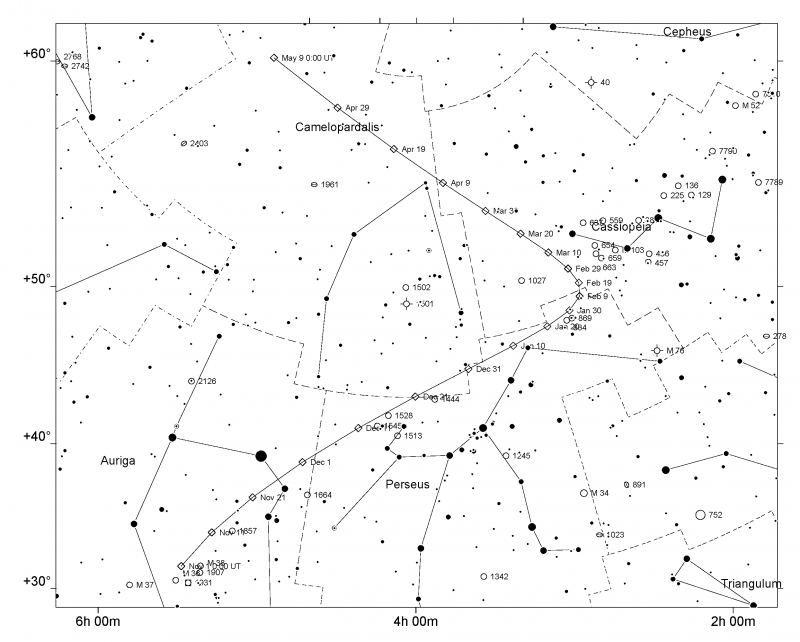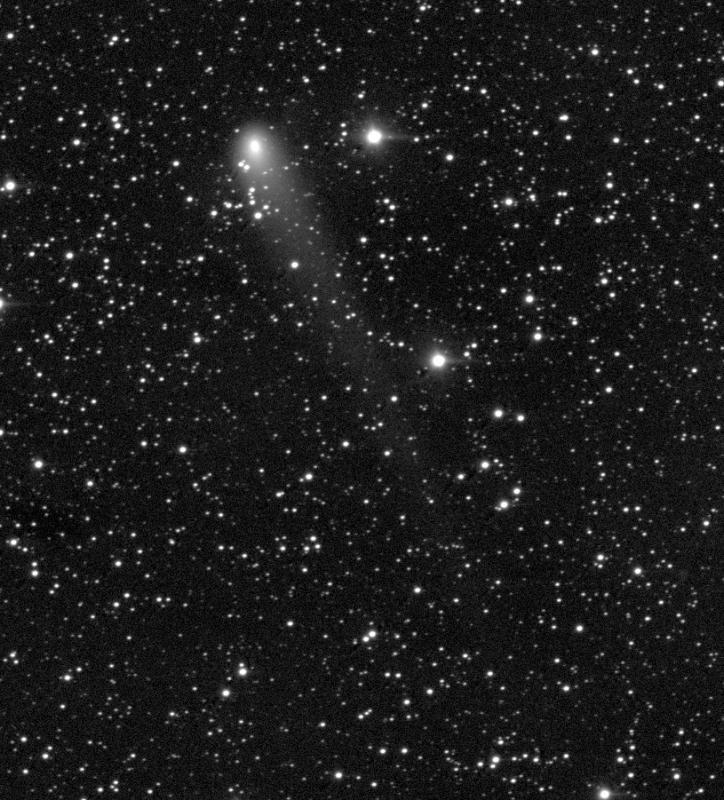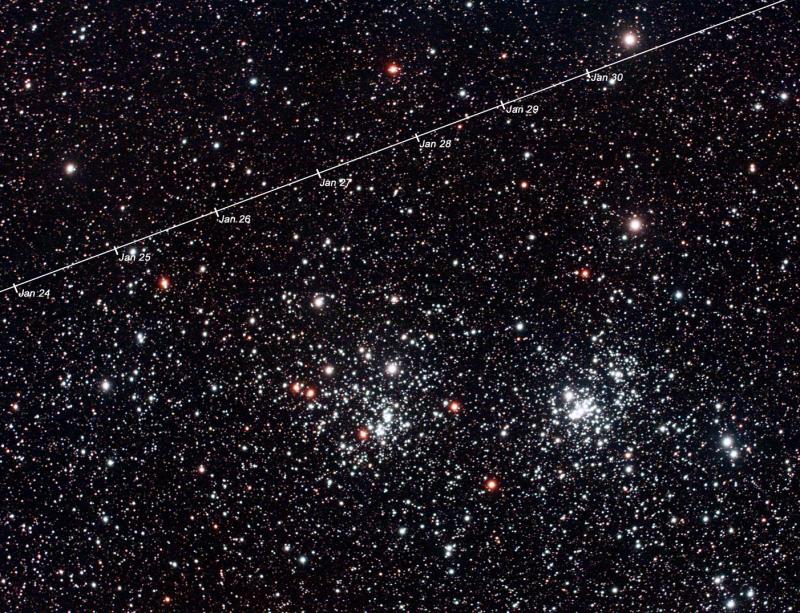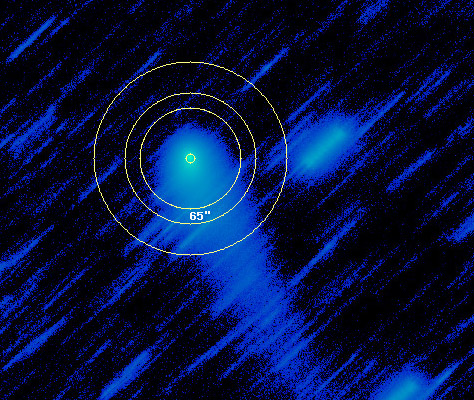2019 December 15
Follow a comet through the northern sky
A relatively bright, circumpolar comet
Comet C/2017 T2 (PanSTARRS) was discovered by the PanSTARRS telescope on Haleakala, Hawai when it was 9.3 au away from the Sun and 20th magnitude. It is moving inwards towards a perihelion which will be at a distance of 1.6 au from the Sun in 2020 May. Comets are often difficult to follow since they are usually at their best when they are close to the Sun in the sky and so can be low down in the dawn or dusk. C/2017 T2 is different. For those of us in the far northern hemisphere it is circumpolar throughout the winter and spring months and it will make a great target for observation from now until perihelion. It is not particularly bright but it is within the range of small telescopes and cameras and since the comet is high up in familiar norther constellations it should be relatively easy to find.

The path of the comet over the next few months is shown in this finder chart (2017t2.pdf). It starts December moving along the Perseus/Camelopardalis border not far from the bright star Mirfak. It continues moving north in Perseus until it crosses the border into Cassiopeia in mid February, finally moving back into Camelopardalis again in April. At present (mid December) the comet is around 10th magnitude and it will continue to brighten slowly through the winter and spring possibly reaching mag 8-9 in April. It may be visible in binoculars from a dark site but small telescopes should definitely provide a good view. The latest lightcurve is here. The comet currently has a short tail about a quarter of a degree long although you will need a dark site to see this.

This is an unusual opportunity to follow a comet for a long period over the long nights of winter and spring to see how it develops as it moves in to perihelion. Observe it whenever you can but the best conditions will be when the Moon is out of the way. There are good Moon-free periods in the last two weeks of December, January and February.
Wide field imaging
While it is not spectacular the comet is bright enough to show up in images taken with small instruments. It also passes close to some nice deep sky objects and so it will be a great target for driven cameras with fairly long telephoto lenses or small telescopes. Of particular note is a close approach to the famous Double Cluster (NGC 869/884) from January 25-30. The path is shown in the figure below. There will be plenty of opportunites to get nice images of the comet and the cluster over that week and the Moon is conveniently New on January 24th. Please submit any images that you get to the Section following the instructions here.

The Double Cluster is the most prominent object that the comet passes but thre are many more pairings that can be imaged with rather longer focal lengths. A list of of the more interesting ones is in the following table. In late May the comet will pass a degree from the galaxy pair M81/M82. The Moon is new on May 22 and the comet will be high in the sky as darkness falls.
| Date | Object |
| 2019-12-23 | Crossing Sh2-205 |
| 2020-01-21 | South of NGC 957 |
| 2020-01-26 | North of NGC 884 |
| 2020-02-23 | 1 deg E of NGC 743 |
| 2020-03-02 | 2 deg W of IC 1805 |
| 2020-03-13 | Passes NGC 886 |
| 2020-04-12 | 1 deg S of NGC 1343 |
| 2020-05-24 | 1 deg from M81/M82 |
Visual observing
Despite all the modern technology involved with comet observing visual observers are still the main source of accurate total magnitude estimates. Estimates of brightness (magnitude), coma diameter and tail length are all important and details of how to make these estimates are given in section 3.7 of the Comet Section Observing Guide which is available for download from here. If you are a new observer please submit estimates that you make to the Comet Section. More experienced observers are encouraged to submit estimates directly to the COBS database. If you are a BAA member registered with COBS please ensure that the BAA is set as your group so that we can download all BAA observations for analysis.
Sketches of the comet are a good way to keep a record of your visual observation. You can submit these to the section by followin the instructions here.
Estimating total magnitudes using imaging
This is a great opportunity to follow a reasonably bright comet for several months as it approaches perihelion and to compare total magnitude estimates from images with those obtained by visual observers. At present there is a quite a large scatter and visual observers at dark sites are seeing the comet rather brigher than imagers. This all comes down to how much of the coma is detected. The section has developed some software called comphot which can be used to estimate comet total magnitudes from images. You can download it from here. Be sure to read the instructions on that page. Doing comet photometry can have a steep learning curve so please contact me if you need any advice. More details are in section 7.3 of the Observing Guide. Images taken for photometry can also be used for measuring the comet’s position. This is called Astrometry and most of our observers use a software program called Astrometrica to do this. Astrometry is covered in section 7.1 of our Observing Guide.

Let’s hope for some good runs of clear, Moonless skies over the next 6 months which will allow us to follow this comet all the way to perihelion. Comets are always interesting to observe since you never know quite what you will see when you go out to observe one. This one is particularly well-placed in our northern skies so don’t miss this opportunity.
Nick James. Comet Section Director.
| The British Astronomical Association supports amateur astronomers around the UK and the rest of the world. Find out more about the BAA or join us. |
